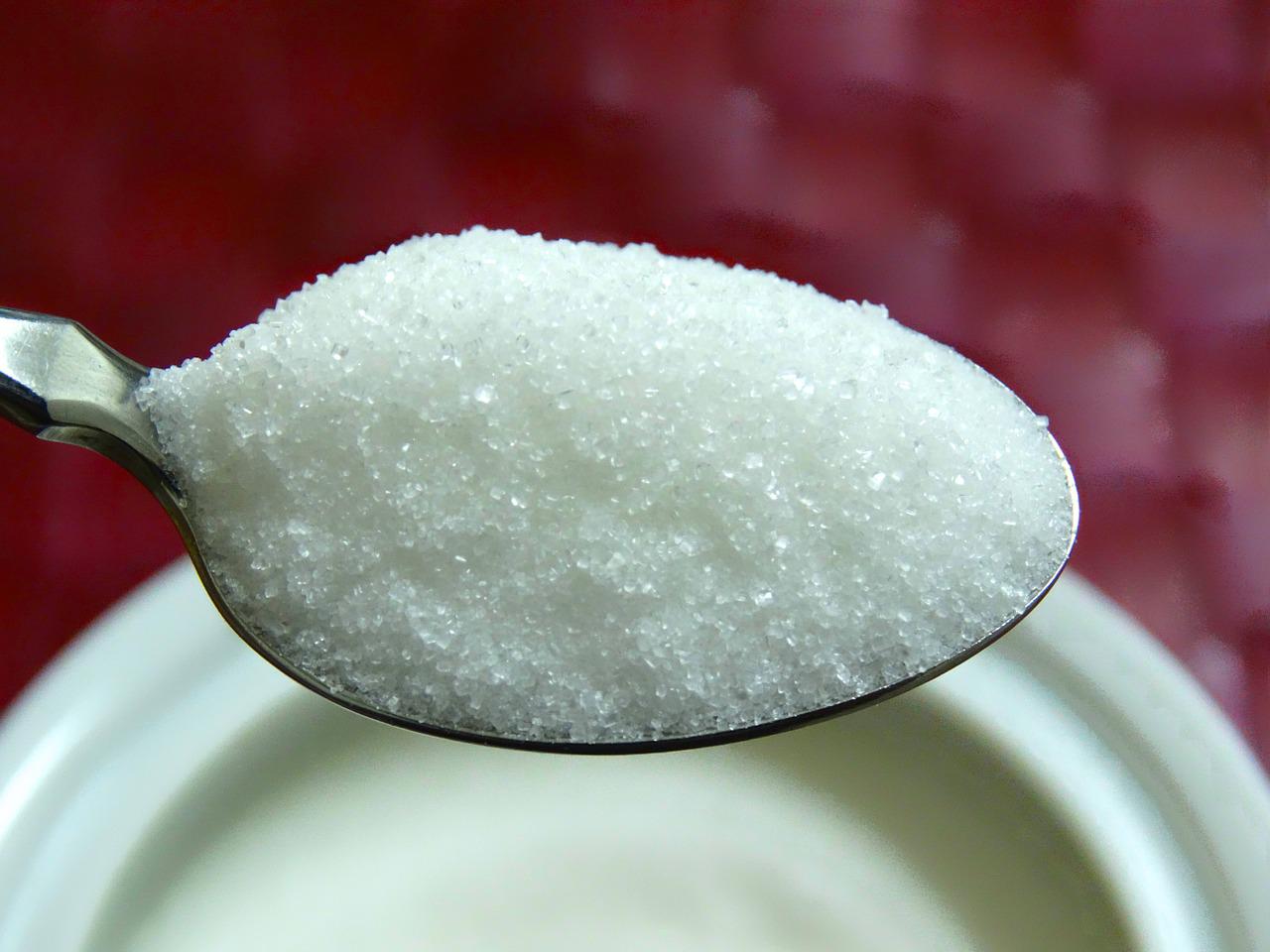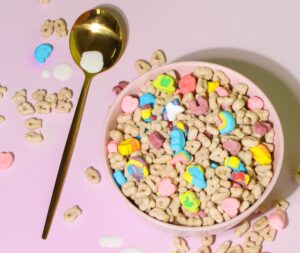Your body doesn’t need to get any carbohydrate from added sugar. That’s why the Healthy Eating Pyramid says sugary drinks and sweets should be used sparingly, if at all, and the Healthy Eating Plate does not include foods with added sugars.

4 grams of sugar = 1 teaspoon
The average American adult, teenager, and child consumes about 17 teaspoons of added sugar a day, or about 270 calories. [1] While we sometimes add sugar or sweeteners like honey to food or beverages, most added sugar comes from processed and prepared foods. The leading sources of added sugars in the U.S. diet are sugar-sweetened beverages, desserts, and sweet snacks like ice cream, pastries, and cookies. [1] Less obvious yet significant contributors are breakfast cereals and yogurt.
The Dietary Guidelines for Americans 2020-2025 advise that all Americans 2 years and older limit added sugars in the diet to less than 10% of total calories. For a 2,000 calorie/day diet, that translates into 200 calories or 50 grams of sugar daily (about 12 teaspoons of sugar). Toddlers and infants younger than 2 years should not be given solids or beverages with any added sugars. [1]
The American Heart Association (AHA) recommends that Americans drastically cut back on added sugar to help slow the obesity and heart disease epidemics. [2]
- The AHA suggests a stricter added-sugar limit of no more than 100 calories per day (about 6 teaspoons or 24 grams) for most adult women and no more than 150 calories per day (about 9 teaspoons or 36 grams of sugar) for most men.
- The AHA also recommends a lower daily limit of added sugars for children ages 2-18 to less than 6 teaspoons or 24 grams per day, and sugary beverages should be limited to no more than 8 ounces a week. [3] For more info, visit Healthy kids ‘sweet enough’ without added sugars.
Spotting sugar on a food label
The updated Nutrition Facts label now lists both “Total Sugars” and underneath “Added Sugars.” The percent Daily Value (DV) for added sugars is based on the recommended limit from the Dietary Guidelines for Americans of less than 50 grams a day (about 12 teaspoons) for an average 2,000 calorie diet. The percent DV will vary: a lower amount for a lower-calorie diet, and higher for a higher-calorie diet. The DV can be an easy way to compare food products for added sugars:
- 5% DV or less of added sugars per serving is considered low
- 20% DV or more of added sugars per serving is considered high
Ingredient list
- Ingredients are listed in descending order by weight, so where sugar is listed in relation to other ingredients can indicate how much sugar a particular food contains.
- Added sugars go by many different names, yet they are all a source of extra calories.
Food makers can also use sweeteners that aren’t technically sugar—a term which is applied only to table sugar, or sucrose—but these other sweeteners are in fact forms of added sugar. Below are some other names for sugar that you may see on food labels:
| Agave nectar | Dextrose | Maltose |
| Brown sugar | Evaporated cane juice | Malt syrup |
| Cane crystals | Fructose | Maple syrup |
| Cane sugar | Fruit juice concentrates | Molasses |
| Coconut sugar | Glucose | Raw sugar |
| Corn sweetener | High-fructose corn syrup | Sucrose |
| Corn syrup | Honey | Syrup |
| Crystalline fructose | Invert sugar |
Key Sources of Added Sugar
Sugary drinks
 Sugary drinks are a prime source of extra calories that can contribute to weight gain and provide no nutritional benefits. Studies indicate that liquid carbohydrates such as sugar-sweetened beverages are less filling than solid food, causing people to continue to feel hungry after drinking them despite their high calories. [4] They are coming under scrutiny for their contributions to the development of type 2 diabetes, heart disease, and other chronic conditions. [5]
Sugary drinks are a prime source of extra calories that can contribute to weight gain and provide no nutritional benefits. Studies indicate that liquid carbohydrates such as sugar-sweetened beverages are less filling than solid food, causing people to continue to feel hungry after drinking them despite their high calories. [4] They are coming under scrutiny for their contributions to the development of type 2 diabetes, heart disease, and other chronic conditions. [5]
- The average 20-ounce bottle of sugar-sweetened soda, lemonade, or iced tea contains about 65 grams of added sugar, often from high-fructose corn syrup. That’s the equivalent of 16 teaspoons of table sugar.
- If you were to drink just one 12-ounce can of a sugar-sweetened soft drink every day, and not cut back on calories elsewhere, you could gain up to 15 pounds over three years. [6]
Be careful to read serving sizes of bottled beverages. Many are sold in 20-ounce bottles, but what is considered one serving of that beverage may still vary among manufactures. For example, a popular cola drink may list the whole 20-ounce bottle as one serving containing 65 grams of added sugar. Another 20-ounce bottle of lemonade may seem a better choice, showing only 27 grams of added sugar per serving—but the label states that one bottle contains 2.5 servings! Therefore, guzzling the whole bottle would give you almost 68 grams of sugar.
To reduce some confusion, the updated Nutrition Facts label mandates that manufacturers list serving sizes based on what people typically consume, rather than how much they should consume. The “typical” beverage serving is now considered 12 ounces (increased from 8 ounces), so hopefully in the near future all beverage labels will list the same standard serving size.
Cereals and other foods
 Choosing minimally processed breakfast foods—such as whole grain toast with nut butter, or a bowl of steel-cut or old-fashioned oatmeal—that don’t have lengthy ingredient lists is a great way to avoid added sugars. Unfortunately, many common breakfast foods such as ready-to-eat breakfast cereals, cereal bars, instant oatmeal with added flavoring, and pastries can contain high amounts of added sugars.
Choosing minimally processed breakfast foods—such as whole grain toast with nut butter, or a bowl of steel-cut or old-fashioned oatmeal—that don’t have lengthy ingredient lists is a great way to avoid added sugars. Unfortunately, many common breakfast foods such as ready-to-eat breakfast cereals, cereal bars, instant oatmeal with added flavoring, and pastries can contain high amounts of added sugars.
Some ingredient lists mask the amount of sugar in a product. To avoid having “sugar” as the first ingredient, food manufacturers may use multiple forms of sugar—each with a different name—and list each one individually on the nutrient label. But don’t be fooled; your body metabolizes all added sugars the same way as it doesn’t distinguish between “brown sugar,” “molasses,” “honey,” and other caloric sweeteners. When reading a label, make sure to spot all sources of added sugars even if they’re not listed as the first few ingredients.
Also be careful of foods that wear a “health halo.” For example, one popular cereal advertises that it contains whole grains, fiber, and several antioxidant vitamins like C, E, and beta-carotene. But it also contains 18 grams of added sugar (4.5 teaspoons) in just one small bowl. Keep in mind serving sizes as well. A crunchy granola bar may contain two bars per pack; just one provides 6 grams of added sugar but if the whole pack is eaten, that number doubles to 12 grams. So you can see how added sugars may add up quickly!
Bottom Line
The body does not need carbohydrates from added sugars to function. A good rule of thumb is to avoid products that have a lot of added sugar, including skipping foods that list “sugar” as the first or second ingredient. However, the products may use a variety of sweeteners so be sure to scan the full ingredient list. Fortunately, the updated Nutrition Facts label in the U.S. now features a separate line for “added sugar” so it easier to know just how much is added versus naturally occurring.
Some tips for reducing added sugar intake:
- Choose plain yogurt with no added sugar and stir in fresh or frozen fruit or unsweetened applesauce and a dash of cinnamon.
- Choose cereals with 5% of the Daily Value or less of added sugars and add sliced ripe banana or berries.
- Choose water, seltzer, herbal tea, coffee and other beverages with no added sugar. Add a slice of orange, lemon, lime, or cucumber for a subtle flavor boost.
- When a sweets craving hits, try one of these first: 1/4 cup of unsweetened dried fruit; 1 cup of ripe fresh fruit; or a 1-ounce square of 75% dark chocolate.
- When baking, reduce the amount of added sugar by 1/4-1/3 cup. Or reduce the sugar by substituting half the amount with unsweetened applesauce or mashed ripe banana; for example, instead of 1 cup of sugar, use ½ cup sugar and ½ cup mashed fruit.
- If you choose to enjoy a favorite treat high in sugar, practice eating a smaller portion than usual. Enjoy it fully by chewing slowly and savoring it.
- Your taste buds can adjust to sweetness levels! As you consistently reduce your total sugar intake, you may notice your sweets cravings lessen or that certain foods now taste too sweet.
Last reviewed April 2022
Terms of Use
The contents of this website are for educational purposes and are not intended to offer personal medical advice. You should seek the advice of your physician or other qualified health provider with any questions you may have regarding a medical condition. Never disregard professional medical advice or delay in seeking it because of something you have read on this website. The Nutrition Source does not recommend or endorse any products.